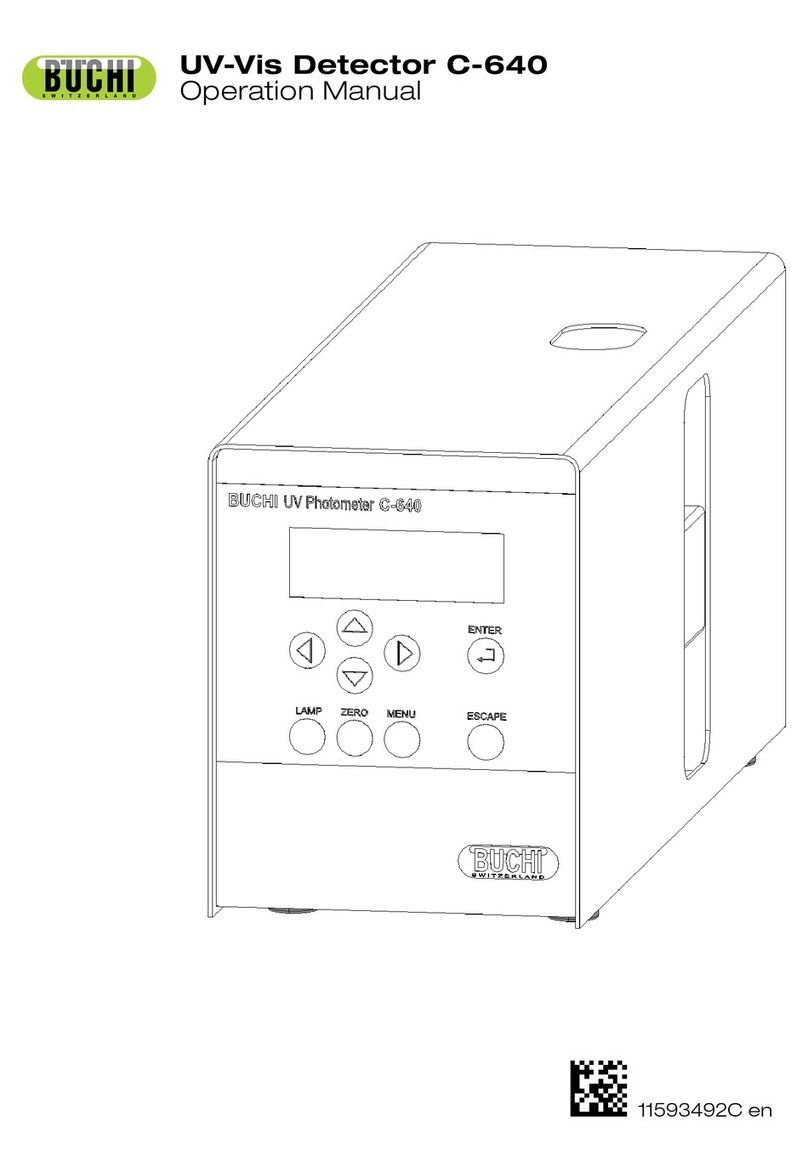
BÜCHI Labortechnik AG
www.buchi.com
3
2. INSTALLATION
2.1 WHAT YOU WILL NEED
In addition to the Model 3300 ELSD detector and its
accessories, the following will be needed for installation of a
complete chromatographic system:
Exhaust System:
•A fume hood or other ventilation device located close
to the detector to remove the detector exhaust from
the laboratory.
Make sure the exhaust system provides adequate but not
excessive suction. Excessive suction can cause a noisy
baseline.
Gas Supply:
•A supply of clean, dry nebulization gas, preferably
nitrogen, regulated from 65 to 80psig. 99.9% purity or
better is recommended. The gas source can be a high-
pressure gas cylinder, high-pressure liquid tank, or a
nitrogen generator.
HPLC System Components:
•An HPLC pump, isocratic or gradient, capable of
low-pulsation solvent delivery at a flow rate ranging
from at least 0.1 to 1.5mL/min against pressures of
at least 3,000psig. Lower flow rate capabilities may
be necessary for smaller bore columns.
•An autosampler or manual injection valve.
•
A column capable of separating the compounds of
interest.
•A guard column or cartridge compatible with the
separation column is recommended to prolong
separation column lifetime.
•A column heater, if needed.
•A data system or integrator, capable of accepting
analog voltage data. 0-10mV or 0-1000mV systems
can be used.
Other:
•HPLC-grade mobile phase solvents.
Only volatile buffers may be used in the mobile phase.
Refer to Section 7.4, Volatile Mobile Phase Modifiers, for a
list of suitable buffers.
•Solvent reservoirs, tubing, inlet filters, paper, etc.
required for pump and data system operation. Consult
the appropriate manuals for requirements.
2.2 UNPACKING
The Model 3300 ELSD detector and its accessories are
shipped in the same container. Unpack components
carefully, making sure all items in the list below have been
included and are in good condition. Save the container and
packing material for future use.
The Model 3300 ELSD shipping container should contain the
following:
•Model 3300 ELSD
•Model 3300 ELSD Operating Manual
•Model 3300 ELSD Performance Documents
•Model 3300 ELSD Driver for Agilent ChemStation CD*
•Power Cord
•Signal Cable
•PEEK Tubing: 1/16" o.d. x .005" i.d., 10’
•SofGripFittings, 10/pk
•Gas Tubing, 10’
•Gas Fittings: 1/8” Brass Nut and Ferrule
•Drain Tubing, 5’ (Reservoir not included)
•Drain Tubing Clamp
•Exhaust Adapter
•Exhaust Tubing, 20’
•14-Pin Connector
•Open-End Wrench, 3/8" x 7/16"
•Open-End Wrench, 1/4" x 5/16"
•Hex Ball Driver, 3/32" x 5 1/4”
•Hex Ball Driver, 7/64" x 4”
•Drift Tube Cleaning Brush
•Fuse, 5 Amp
*The Model 3300 ELSD Driver for Agilent ChemStation CD
can be used with Agilent ChemStation to control and collect
data from the 3300 ELSD. Agilent ChemStation must be
purchased separately.
The Model 3300 ELSD has been carefully shipped to ensure
that it is received in proper condition. Any damage to the
container or its contents should be reported immediately to
your local BUCHI Customer Service office which can be
found on the BUCHI website at: www.buchi.com. Please
refer to Section 7.5, Warranty, Returns, and Repairs, for
more information.
Refer to Section 7.2, Replacement Parts, for part numbers if
replacement parts are needed.




























